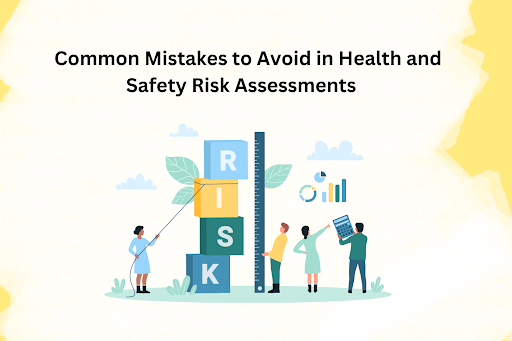
A healthy and safe workplace is Indispensable in every organisation. Practical risk assessments and robust safety programs in organisations can achieve this effectively. Risk assessments include identifying, assessing, and minimising possible hazards. The efficacy of these practices is affected and compromised by common mistakes that occur in risk assessments. This blog discusses the typical errors to avoid while evaluating the risks with solid safety programmes. To effectively understand and explore Health and Safety Risk Assessment methods, professionals engaged in risk assessments are urged to enrol in the IOSH Course.
Table Of Contents
- The Role of Health and Safety Risk Assessments
- Mistakes to Avoid in Risk Assessments
- Conclusion
The Role of Health and Safety Risk Assessments
Health and safety risk assessments are fundamental building blocks of a strong safety culture in every organisation. Identifying possible hazards is the foremost consideration. Then the careful analysis of the risks and applying precautions to minimise these risks are the processes to continue.
Health and safety risk assessments safeguard against legal liability for the organisation. It is applicable for the employees as well. Implementing a well-defined risk assessment approach that complies with regulatory standards are the key to success for every organisations.
Mistakes to Avoid in Risk Assessments
Let’s explore the common mistakes organisations should consider in guaranteeing the success of their risk assessments.
Improper Involvement of Stakeholders
A significant mistake in risk assessments is to include the stakeholders in an inappropriate method. It is imperative to involve professionals of all levels as they provide invaluable perspectives on day-to-day operations and any potential risks. This inclusive approach ensures a more complete and efficient risk assessment procedure.
Lack of Comprehensive Training
Inadequate training can lead to mistakes, poor decisions, and a lack of competence during evaluation. Misunderstanding the importance of risk assessment is the outcome of insufficient training. Continuous education, such as IOSH courses, is essential for providing people with the skills they need to handle the complexity of risk assessment.
Neglecting to Review and Update Assessments Regularly
One common mistake is the need for regular review and update of risk assessments. Assessments can become out of date without regular reviews, which can result in inefficient management methods. Keeping records of periodic reviews is helpful for proper tracking and for taking effective measures.
Overlooking Psychological and Ergonomic Factors
Psychological and ergonomic factors allow for ease of use by humans. Risks at work can be physical hazards such as stress and exhaustion, but inadequate ergonomic design plays a role here. The thoroughness of a risk assessment is compromised when psychological and ergonomic factors are overlooked.
Relying Solely on Generic Templates
Depending only on generic templates is not the right way, as every workplace is different. A one-size-fits-all strategy runs the danger of overlooking essential hazards or adding needless complexity. Tailoring templates to the company’s procedures is essential to a successful risk assessment. There should be some considerations beyond the organisation’s limits as well.
Focusing Only on Immediate Hazards
Long-term risks are equally crucial to immediate high-risk hazards, and both need to be treated well to ensure employee well-being. The need for a comprehensive approach to risk management is underscored by ignoring long-term, chronic hazards that jeopardise the organization’s ability to grow and develop while also adversely affecting employee well-being.
Insufficient Documentation
Documentation is an essential part of an organisation’s practical risk assessment. Maintaining proper documentation helps to track the record at any point during organisational development. Insufficient documentation leads to reduced efficiency in risk assessments. The accurate documentation of daily tasks can reach the different levels of organisation.
Failure to Communicate Findings Effectively
Even the most thorough risk assessment is rendered useless by poor communication of findings. Employee comprehension of recognised dangers, preventative measures, and their responsibilities for upholding a safe workplace are all ensured by transparent communication. The acceptance of standard compliance methods occurs through proper communication with the employees.
Disregarding Employee Feedback
Ignorance of Employee Feedback is a significant mistake, as employees are the heart of every organisation. A risk assessment programme that is more responsive is fostered by a culture that values employee feedback and promotes open communication. Welcoming criticisms helps the growth of the organisation.
Lack of Continual Improvement
It is essential to consider risk assessments as a continuous process and the best way for organisational improvement. Continually evaluating control measures’ efficacy and looking for ways to improve them improves overall safety. Ongoing assessments provide a better understanding of the health and safety risk assessments and improve operational methods.
Conclusion
As organizations prioritize the safety of all work environments, health and safety risk assessments, along with robust safety programs, are considered critical. The implementation of comprehensive Health & Safety Courses becomes imperative to address potential weaknesses in the evaluation procedure, emphasizing the need for a thorough and sophisticated strategy.
Common mistakes such as Inadequate Involvement of Stakeholders, Lack of Comprehensive Training, Neglecting to Review and Update Assessments Regularly, and Overlooking Psychological and Ergonomic Factors are crucial to be taken care along with Relying Solely on Generic Templates, Focusing Only on Immediate Hazards, Insufficient Documentation, Failure to Communicate Findings Effectively. Improvement must be ongoing in every organisation to maintain a safe work environment. Integrating professional development, like IOSH courses, guarantees that those in charge of risk assessments are equipped to handle the complexities of safety management.
Stay in touch to get more updates & news on Glamour tribune!
